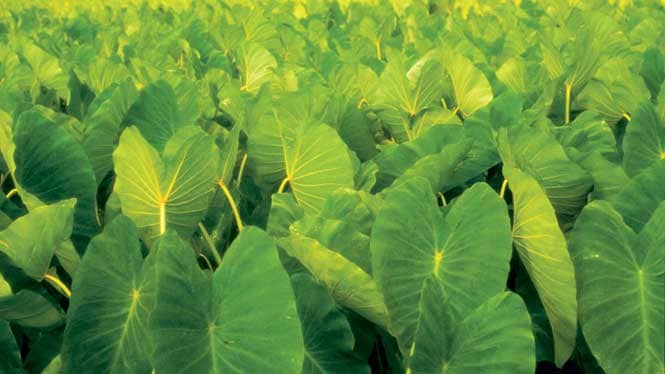Although varieties of taro are grown in nearly all the world’s tropical regions, the plant maintains its closest ties to Hawaii. For many Hawaiians, in fact, taro represents the staff of life.
Waipā ahupua’a on Kaua’i, students learn about traditional Hawaiian techniques for growing taro.
One Hawaiian legend tells of Wakea, Father Heaven, who bore a child with the Daughter of Earth. Born prematurely, the deformed infant, Haloa, was in the shape of a bulb. Wakea buried the body at one corner of his house. The couple’s second-born child, also named Haloa, was a healthy boy who would become the ancestor of the Hawaiian people. Haloa was to respect and look after his older brother for all eternity. The elder Haloa, the root of life, would always sustain and nourish his young brother and his descendants.
Early Hawaiians supposedly consumed up to 15 pounds of taro (as poi), per person, on a daily basis. It was such a revered source of nourishment that only men were allowed to grow it.
Even today, much of the Hawaiian culture is based on taro cultivation. For example, no one is allowed to fight or argue when a bowl of poi is open. According to Hawaiian custom, it is disrespectful to fight in front of an elder. And as the living embodiment of Haloa, taro is the “elder brother” of all Hawaiians.

What is Taro?
Taro is cultivated using both dryland and wetland methods. It’s primarily used for making poi, that starchy, pasty staple served at every Hawaiian luau. But it’s also used to make taro chips. The taro leaves are used for luaus as well.
Life as a taro farmer is often demanding and relentless, and the financial return can be slow. Farmers often work knee-deep in mud and water in deep valleys far removed from the conveniences of modern society. Today’s taro farmers also face problems that go beyond droughts, hurricanes, and other natural calamities. One major pest is the apple snail, which was promoted in the late 1980s as a potential aquacultural product for Hawaii. In the early 1990s, the snails began to appear in taro fields, devouring taro plants with alarming efficiency. As a result, taro production in Hawaii declined to a record low of five million pounds in 2003, down 18 percent from the previous year. For consumers, this means smaller inventories and higher prices.
Nonetheless, for many of Hawaii’s people, taro remains a way of life—the heartbeat of the land and its people.
